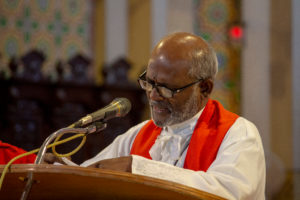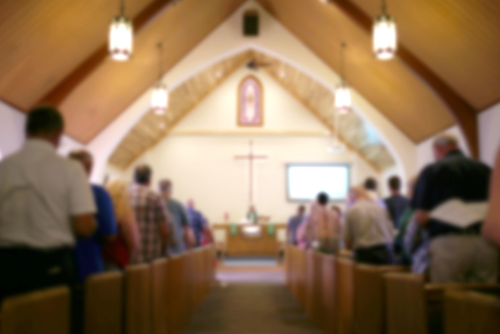 You may be curious about the differences between a pastor vs priest if you want to go into Christian ministry. Although people occasionally use the two terms synonymously, there are differences in how the titles of pastor and priest are typically used and understood. Knowing the differences is helpful if you are considering pursuing a role in Christian leadership.
You may be curious about the differences between a pastor vs priest if you want to go into Christian ministry. Although people occasionally use the two terms synonymously, there are differences in how the titles of pastor and priest are typically used and understood. Knowing the differences is helpful if you are considering pursuing a role in Christian leadership.
Differences in the Titles
The specific use of the title of pastor is for leaders in Protestant or non-denominational churches. Non-denominational churches are not a part of any of the mainline Christian denominations such as the Catholic, Baptist, Lutheran, or Methodist churches.
You may already know that the title of pastor is related to the words “pastoral” and “pasture.” As a title for a Christian leader, a pastor means someone who shepherds or guides a congregation, providing for their spiritual nurture. Since the late 1800s, the word has even been in use as a verb. For instance, a Christian minister could say that they “pastor” a church or congregation. Pastors may also use the titles of minister or reverend.
The word priest has its origins in the Greek word presbyteros and the Latin word presbyter. The title of priest essentially means elder. A priest refers to a pastor or minister who serves in the Catholic or Greek Orthodox traditions. Anglicans, who have ties to both the historic Catholic Church and the reformed tradition, also use the word priest.
A priest serves in a historic Christian tradition that emphasizes liturgical worship. This tradition includes an emphasis on the celebration of the Eucharist or Mass. It is not quite as simple as saying Protestant Christian congregational leaders are called pastors and Anglican, Orthodox, and Catholic leaders are called priests, but that is part of the distinction. While a priest may be called a pastor, in the term’s general sense, pastors are never called priests because of the distinct roles pastors and priests have in the church.
Other Differences
Protestant pastors are not required to be celibate, and some Protestant denominations ordain women as pastors. Ordaining women as pastors depends on a particular denomination’s history and practice. Educational requirements may also differ among the various denominations. Most long-established traditions, including the historical liturgical churches and mainline Protestant churches, require seminary training and a rigorous ordination process.
Some smaller Protestant and non-denominational churches, especially those based on a looser and less hierarchical structure, may not require seminary. Yet, all candidates are encouraged to attend Bible college. You will also hear in some Protestant churches the term “lay pastor.” A lay pastor refers to someone who is not ordained but serves a pastoral role in a church congregation.
Priests in the Greek Orthodox and Roman Catholic traditions must be male. Catholic priests must be celibate, though Greek Orthodox priests can marry before ordination. Anglican priests may marry and can be either male or female within the American branches of the tradition.
Training and Education to Become a Pastor
A Protestant or non-denominational church pastor has many duties beyond writing and delivering sermons and leading church services. Many responsibilities of a pastor include:
• Presiding over baptisms, weddings, and funerals
• Counseling members of the congregation during their time of need
• Organizing community outreach events
• Reaching out to new members
• Working with community leaders in the private and public sectors
• Overseeing church business and finances
People feel a special call to serve as a pastor. They need to have a deep knowledge of the Bible and the tenets of their denomination. Candidates need to talk to the pastor or their church to express their interest in becoming a pastor. The candidate will meet with the church committee to review their background and qualifications. The candidate must be in good standing with the church.
Once the committee agrees the candidate can move forward, the candidate will need to start taking college courses and completing a degree program at a private religious college or university. Some churches require a prospective pastoral candidate to receive a Master of Divinity degree. There may be several other requirements for prospective pastorship candidates in addition to taking college courses. These include:
• Completing an internship
• Attending seminars
• Passing various exams
• Working with a mentor
Individual churches and the various Christian denominations have different requirements to become a pastor. Before a prospective pastoral candidate embarks on this journey, they must know the specific prerequisite of their church and denomination. A pastor does not have to be ordained to lead a church. Yet, ordination is recommended, especially for pastors in bigger Protestant and non-denominational churches.
Training and Education to Become a Priest
Becoming a priest typically starts in the family where a child goes through a discernment process of praying for guidance over a decision. The child goes through the discernment process with the help of the family and the priest. Joining the priesthood is not a decision that is taken lightly and is often a years-long process.
Priesthood is only for baptized, confirmed, and practicing Catholic men who desire to serve God and His people. Priests cannot marry, have been divorced, consider themselves members of the LGBTQ community, or have been dismissed from another priestly formation program.
A priest has a call to shepherd the flock, proclaim the word of God, teach the faith, minister the sacraments, and be a steward of the church. A college or university degree is usually not required, but all prospective candidates for the priesthood must attend seminary and receive a degree from the seminary. Men must go through a selection process and have the church choose them as candidates for the priesthood. There are general requirements to becoming a priest. Some of these requirements include:
• Having good physical health, emotional balance, and maturity
• Having a deep prayer and devotional life
• Recognizing and willing to help those in need.
• Being a member of the Catholic faith for at least two years
Every diocese, or a Catholic district under the care of a bishop, has different requirements to enter the priesthood. Every candidate should research the priesthood requirements of their diocese before starting the process.
Distinctions in Attire
The style of dress is another important area of distinction between pastors and priests. Pastors are less bound by one set of rules on how to dress. Due to the various denominations across non-Catholic Christianity, there are noticeable variations in what pastors wear at worship time. In some individual churches and Christian denominations, the pastor will regularly wear a robe with various church symbols. In many cases, pastors will wear casual attire such as a suit, sport coat, tie, dress pants, and dress shoes.
Yet, other pastors wear jeans, T-shirts, sandals while sporting tattoos. These relaxed dress rules have led to a lot of debate about the proper attire for pastors. Mainline Christian denominations and large non-denominational churches are more strict about dress code rules than smaller non-denominational churches.
Priests have a strict standard in the Catholic tradition to wear a series of symbolic layers. The amice, alb, cincture, stole, and chasuble is the main priestly vestments, and each has vital meanings for the church. Here are what these vestments stand for:
• Amice – The amice is a white rectangular-shaped piece of linen that hangs from the neck and down the back to the waist. It symbolizes the defense against the devil the use of moderation in speech.
• Alb – The alb is a long white outer garment that goes from the neck down to the ankles and has long sleeves that go to the wrists. The alb symbolizes the pure heart a priest must bring to the alter.
• Cincture – The cincture is like a belt for the alb. It is a long thick cord that is tied around the waist and has tassels at each end. The cincture symbolize the virtue of purity.
• Stole – The stole is a long, four-inch-wide cloth worn like a scarf and secured by the cincture. It represents priestly power and authority.
• Chasuble – This outer garment is worn over the alb and stole. The chasuble is like a long coat that covers the entire body and symbolize the virtue of charity.
The color of priestly vestments also has symbolic significance. Liturgical colors and their importance include:
• Green – Represents ordinary times on the liturgical calendar and signifies hope.
• Red – Represents Pentecost, the Holy Spirit, and feasts of the Apostles and martyrs. Red signifies the blood of Christ and the fire of charity.
• Yellow – Used during various feasts on the liturgical calendar and signifies glory, joy, innocence, and the purity of the soul.
• Pink – Used during the third Sunday of Advent and the Fourth Sunday of Lent. Pink symbolize love and joy.
• Purple – Used during Advent, Lent, and during Requiem Masses. Purple symbolize humility and penitence.
Distinctions in Hierarchical Epicenters
One more interesting distinction between pastors, priests, and their associated church bodies is the hierarchical epicenter. In the Protestant denominations of Christianity, there is no centralized heart of administrative or organizational function. Each denomination typically has leadership and organizational structures that are unique to that denomination. Pastoral and priestly organizations do not interact with each other in most cases, except when mutual Christianity-wide matters of concern occur.
In Catholicism, the absolute epicenter of church organization and administration is Vatican City. Here, a Pope and royal, holy structures and grounds make up the seat of the church. There are six levels of hierarchy in the Catholic church. These levels are:
• Deacon – These are men who are at the final stage of priesthood training and can fulfill some of the duties of active priests.
• Priests – Successful Deacons can become priests once they undertake the Rite of Ordination, which ordains them into the priesthood.
• Bishop – Priests can become bishops when they are at least 35 years of age, ordained for at least five years, and hold a doctorate in theology. Bishops must have extensive experience in canon law and sacred scripture.
• Archbishop – The next level is the archbishops who oversee an archdiocese, which is a group of dioceses and manages the bishops in that region.
• Cardinal – There are around 130 cardinals. Cardinals oversee the bishops. Their most important role is to vote for a new pope.
• Pope – The pope is the leader of the Roman Catholic church around the world.
As you can see, Catholicism has a lot more structure and traditional practices than the Protestant and non-denominational Christian traditions.
Associated Professional Organizations
In all hierarchical associations, pastoral and priestly professional organizations also do not typically interact with one another on a regular operational basis. Therefore, both priests and pastors prescribe to their distinct professional associations and organizations. The following represent a few of the most important of those organizations for both priests and pastors.
Organizations for Priests
The Association of Catholic Priests is a leading organization that binds all participating priests in a very valuable, resource-filled network of other priests and Catholic components.
The Association of US Catholic Priests is another, major representative force in Catholicism and greater priesthood that provides networking, resources, relevant news, links to important events, and more.
Organizations for Pastors
The National Association of Christian Ministers is a leading group serving the greater pastoral community in the United States specifically. Here, members and others can find a rich array of resources, information contacts, news, and more.
The American Pastors Network represents yet one more, excellent and very authoritative organization for the whole of the pastoral world. This group provides a notably large networking experience, video and radio media products, up-to-date news pieces, and plenty more. All media programing from the website can also be easily accessed in mobile format with the organization’s “Stand In The Gap” mobile app.
Though the terms pastor and priest are not entirely interchangeable, they are related, and both refer to Christian leaders. Ultimately, the very common questions regarding “pastor vs. priest” subject matter might be best understood within the context of a particular Christian tradition.
Related Resources:


